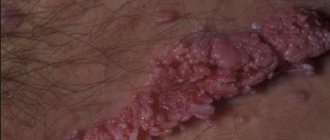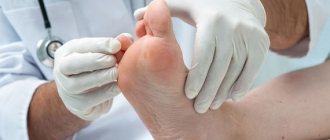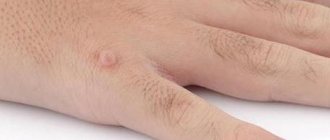Intraductal papilloma (ductal papilloma).
Removal of papilloma on the nipple
Ductal papilloma (intraductal papilloma) occurs near the nipple; removal of papilloma on the nipple is possible using electrocoagulation under local anesthesia. Signs of intraductal papilloma (or nipple papilloma) are the appearance of blood-stained or transparent discharge from one nipple. Ductal papilloma is often a precancerous condition. Treatment of papillomas on the nipple and intraductal papilloma is carried out by a mammologist-oncologist.
On the picture:
papillomas on the face
The human papillomavirus (HPV) is widespread throughout the world. HPV causes warts, papillomas, and genital warts. Different types of human papillomavirus (there are more than 100 of them) cause different diseases.
Genital warts are small skin-colored formations, their size ranges from 1 mm to several centimeters. Genital warts can form on the genitals, near the anus, on the face, even in the mouth, on the body, abdomen, in the groin area, and in the armpits. This is a viral disease. The causative agent of genital warts is the human papillomavirus (HPV).
In men, the glans penis and frenulum of the foreskin are most often affected. In women, damage by the human papillomavirus appears on the labia, clitoris, vagina, and cervix.
Genital warts can be localized around the anus.
From single ones, genital warts can grow into rashes that can spread, taking on the appearance of cauliflower. “High-risk” HPV types (16, 18, 31, 33 and 35) cause cervical dysplasia and can become malignant.
Causes of papillomas
Provoking factors for the appearance of papillomas:
- Hypovitaminosis and vitamin deficiency;
- Overwork;
- Nervous-emotional stress;
- Hormonal disorders;
- Harmful factors: smoking, drinking alcohol, drugs;
- Long-term use of contraceptives containing hormones (pills, IUDs, vaginal ring);
- Reduced immunity;
- Early onset of sexual activity;
- Promiscuous sexual intercourse;
- sex without using barrier methods of contraception;
Genital warts - routes of infection
The route of infection with HPV is contact. But household infection with the human papillomavirus is also possible. When a person comes into contact with infected skin or mucous membranes of a sick person, HPV infection occurs. Very often, this does not appear outwardly; the virus may not show itself for a long time. But under certain conditions (decreased immunity, concomitant diseases), HPV is released onto the surface of the skin and mucous membranes. In a latent (dormant) state, infection of other people with HPV is rare. From the moment of HPV infection to the appearance of genital warts, it can take from several weeks to several years.
Photo of condylomas on the genitals and in the perianal area
| In the photo: condylomas on the foreskin and on the frenulum of the penis | In the photo: genital warts in the perineum | In the photo: papillomas in the anus |
There are “low-risk” and “high-risk” types of HPV. Genital warts are caused by “low-risk” HPV types 6 and 11.
Papillomas in an intimate place during pregnancy
Features of the course of pregnancy in the presence of papilloma in an intimate place:
- There is a high probability of malignancy of the formations.
- Effect on the fetus: high probability of infection of the newborn after passing through the birth canal. Papillomatosis of the oral cavity and throat or respiratory tract develops.
- If during pregnancy there is active growth and proliferation of papillomas, a threat to the life of the fetus appears, the doctor considers removing the tumors. The method of destroying papillomas is chosen by the doctor depending on the condition of the expectant mother’s body and the degree of development of the disease.
- During childbirth, bleeding may begin due to neoplasms, so delivery by cesarean section is preferable.
Treatment of papillomas, condylomas (HPV)
- performed on the body by a dermatologist-cosmetologist,
- on the male genitals - urologist,
- for women - a gynecologist,
- in the area of the anus and perineum - a proctologist.
There is now a treatment that is highly likely to eliminate HPV infection. Modern treatment for genital warts can not only remove or reduce the symptoms of the disease, it eliminates the HPV infection and prevents further transmission of the virus in many cases. However, after any treatment method, relapses are possible.
- Laser removal of genital warts is performed under local anesthesia.
- Electrocoagulation, removal of genital warts using high temperature, is carried out under local anesthesia.
- Interferon blockades (genital warts are injected with an interferon drug).
- Radio wave removal of condylomas. Today, the most effective method for removing genital warts. There is no trace left of condylomas.
Hardware removal of papillomas
Treatment of neoplasms in the intimate area is carried out using several methods. The doctor chooses it individually for each patient in accordance with the stage of papillomas and the presence of concomitant diseases.
Cryodestruction
Destruction of new growths with liquid nitrogen , which has an ultra-low boiling point (-196ᵒ C). Today it is one of the most popular and safe methods of removing papillomas.
Advantages:
- simplicity and speed of the procedure;
- does not require additional preparation;
- safety and absence of complications;
- After removal, the patient goes home and leads a normal life.
Flaws:
- It is impossible to control the penetration depth of liquid nitrogen.
- limited use in the case of large formations and multiple papillomas due to the risk of damage to healthy tissue.
Indications for use of this method:
- Papillomas cause discomfort and pain;
- The tumor grows too quickly and changes color or shape.
The procedure is performed in 2 ways:
- Hardware (uses a cryodestructor with an attachment)
- Manual (performed with an applicator, the end of which is wrapped in cotton wool soaked in liquid nitrogen).
After cryodestruction, the skin becomes pinkish-white, and the next day a bubble filled with liquid forms. After some time, the bubble dries out, a crust appears, under which healthy tissue forms.
Laser treatment
Destruction of growths with a surgical laser . After the procedure, there are no scars or bleeding; a dimple is formed, which disappears after a few weeks.
Advantages:
- Quick removal of papillomas within a few minutes.
- Effective and safe destruction of formations.
- There is no contact of the instrument with the skin during the procedure, which eliminates the possibility of infection.
- The laser penetration depth is adjusted to the depth of papilloma penetration.
- The procedure allows the destruction of pathological formations on any part of the body.
- Bleeding is eliminated, as the blood vessels are sealed.
- Fast recovery.
Indications:
- Localization of papilloma in that area of the body in which the neoplasm can be damaged with a high degree of probability.
- The appearance of pain in the area of the tumor.
- Growth of pathological formation.
Advantages of treating human papillomavirus at Deltaclinic
- Our clinic has all the necessary specialists (dermatologist, dermatologist-oncologist, proctologist, urologist, gynecologist) who remove condylomas and papillomas of any location.
- The most modern equipment (lasers, electrocoagulation, radio wave), which allows you to get rid of condylomas on the day of the visit.
- Condylomas are removed without leaving a trace. Excellent cosmetic effect - no trace remains on the skin and mucous membranes.
- Fast healing time.
- An accurate diagnosis of the type of papillomavirus is carried out. General immunostimulating and antiviral therapy is prescribed.
- Removal of candylomas is carried out on an outpatient basis; hospitalization is not required.
Photo:
Surgitron device for non-surgical (radio wave) removal of condylomas.
Do not delay your visit to the doctor, genital warts must be removed! If papillomas are not removed, they can spread throughout the body. The virus can be transmitted to other people with whom an HPV-infected person comes into contact. A woman can infect her fetus during childbirth. Cases of familial infection with the human papillomavirus are common.
Folk remedies for papillomas in the intimate area
Traditional recipes for the treatment of papillomas:
- Celandine. The juice is squeezed out from the fresh stems of the plant. Gauze is moistened with celandine juice and applied to the affected areas. The procedure is performed twice a day for 2 weeks.
- Potato juice. The tuber is wiped and wrung out with gauze. Drink the resulting juice 0.5 cups for 2 months, half an hour before meals.
- Garlic: A couple of cloves of garlic are put through a garlic press. Then mix 1 tsp. gruel of this plant with 2 tbsp. l. any cream. The resulting mixture is spread on a bandage and fixed to the neoplasm. After 5 hours, wash off.
- Take a couple of cloves of garlic and crush them. Add lemon crushed in a food processor and 0.5 cups of apple juice. Then the resulting mixture is poured with red wine (half a glass) and infused for several hours. After time, the infusion is filtered. Drink on an empty stomach once a day.
Tests for an immunologist and an immunogram for pubic papillomas
Papillomas almost always appear against a background of reduced immunity.
Therefore, patients need to consult an immunologist and conduct a study of the activity of the immune system.
This is necessary because:
- allows us to predict the development of the disease
- makes it possible to select immunomodulatory therapy
A person with poor immunity suffers not only from papillomas.
He exposes himself to the risk of dangerous infectious diseases.
Nonspecific inflammatory processes may occur in the body.
Therefore, even after removal of papillomas, it is worth adjusting the immune system.
This will help avoid recurrence of the formation of anogenital warts.
It will also prevent other diseases of infectious origin.
Side effects of immunomodulators for papillomas
Flu-like conditions often develop when interferons are used.
Body temperature rises, signs of inflammation of the upper respiratory tract appear.
There is a headache.
The higher the dose, the greater the risk of side effects.
They can be relieved by using non-steroidal anti-inflammatory drugs.
When using cytokine inducers, local reactions may occur.
This is redness, swelling, and the formation of erosions on the skin.
Methods of infection with papillomas
If a papilloma appears on the pubis, most likely the infection occurred through sexual contact.
Human papillomavirus infection is a disease with a predominantly sexual transmission method.
Although it can also infect humans through close household contact.
But it is obvious that in everyday life people do not touch each other’s pubis or genitals.
Therefore, taking into account localization, if you find papillomas in yourself, this is a “gift” from your sexual partner.
Moreover, the infection could have occurred quite a long time ago.
It is likely that it took place several months ago.
For this reason, it is often not possible to determine the source of infection.
Laser vaporization of pubic papillomas
A laser is used to destroy pubic papillomas.
With short pulses, the tissues are heated to such an extent that they simply evaporate.
In this case, the areas of skin located next to the papilloma are not affected.
The laser allows you to evaporate papilloma with maximum precision.
There is a risk of scarring, but it is small.
Less than when using electrocoagulation.
The laser coagulates blood vessels more effectively.
This is a non-contact technique.
Therefore, there is not the slightest risk of wound infection during the procedure.
If the infection gets into the skin, this can only happen after removal, if the patient does not follow the doctor’s recommendations.
But there are also disadvantages.
Only small or medium-sized papillomas can be removed.
Large formations are usually not removed with a laser, preferring other methods.
Plus, there is no material left for histological examination.
If it is necessary, then preference is given to other methods of combating pubic papillomas.
Pubic papillomas: immunological treatment and antiviral drugs
After papillomas are removed, doctors often prescribe treatment to suppress the virus.
Applicable:
- means for stimulating the immune system
- general antiviral drugs
Interferons are most often prescribed.
They simultaneously stimulate the immune system, kill viruses and have antiproliferative activity.
Used locally and systemically.
Local interferons have low effectiveness against HPV.
Therefore, they are rarely used in monotherapy.
Mostly prescribed in addition to systemic medications.
For pubic papillomas, alpha interferon is prescribed intramuscularly or subcutaneously.
It is used in a dose of 1.5 to 3 million IU, every other day.
The course of treatment is 1 month.
After such a course, papillomas sometimes disappear even without their physical removal.
Local therapy is also used.
The drugs are injected into the lesions or applied in the form of a gel.
Cytokine inducers are also used.
Imiquimod is prescribed as a 5% cream at night.
It is used in a course of several months.
Warts disappear in 50-60% of cases.
Without treatment, over the same period they disappear in only 15% of patients.
For the treatment of HPV, inducers of endogenous interferon synthesis can be prescribed.
They are mainly used in combination with the destruction of pubic warts.
The drug Gepon is used.
Mechanisms of action:
- increased interferon production
- suppression of HPV replication
- increased macrophage activity
- decreased cytokine production and decreased inflammatory response
- increased antibody production
- increased nonspecific resistance of the body
The drug is prescribed orally at a dose of 2 mg, 3 times a week.
Other medicines that may also be used include:
Isoprinosine - a course of 5 days, 50 mg per kg per day in three doses, a total of 3 courses are needed.
Panavir - after one injection increases the level of leukocyte interferon by 3 times.
Glycyrrhizic acid – activates local immunity, blocks the introduction of the virus into the cell.
There are many other drugs that destroy viruses or enhance immunity.
Which of them should be prescribed is decided by the immunologist.
The decision is made based on the results of the immunogram.
Histology and oncocytology for papillomas
HPV is dangerous for the body.
Especially for women.
In them, the presence of papillomas can result in cervical cancer.
But the virus is dangerous in men too.
In both sexes, HPV causes squamous cell carcinoma.
In total, about 180 types of virus are known.
Of these, 29 have oncogenic potential.
Therefore, it is advisable to examine women with identified papillomas.
They need regular monitoring while the virus is in the body.
Even if the papillomas are removed, the risk of cancer remains.
To avoid pathology, it is worth taking a smear for oncocytology once every six months.
It is taken from the cervix.
The doctor checks whether there are atypical cells in it.
If necessary, if the result of an oncocytology test is unfavorable, clarifying studies are prescribed.
The doctor performs a colposcopy.
Using a special device, he examines the vaginal part of the cervix under a magnification of several tens of times.
This way the doctor can see pathologically changed areas of the epithelium.
Before developing into cancer, the papilloma virus causes dysplasia.
At first it has the first degree, then the second.
Both are reversible.
The first degree regresses on its own in most women, the second - only in 30%.
With the third degree, the risk of degeneration into cancer reaches 80%.
Therefore, grade 2-3 dysplasia is an indication for surgical treatment.
Pathological areas of the altered epithelium are “cauterized.”
This helps prevent cancer.
Timely performance of oncocytology is of utmost importance in the early detection of dysplasia.
A woman who is not lazy to visit a gynecologist once every six months can prevent cervical cancer with almost 100% success.
Sometimes, at the time of removal, papillomas already look suspicious.
In unfavorable cases, they can degenerate into squamous cell carcinoma.
Then they are sent for histological examination after removal.
The doctor examines the structure of the tissue and looks for signs of malignancy.
Histological diagnosis is also used if it is necessary to distinguish papilloma from other benign skin tumors.
If signs of malignancy are detected, the scope of the operation can be expanded.
Next, we will consider what methods are used to remove papillomas, what advantages and disadvantages they have.
Tests for diagnosing papillomavirus
The very fact of detection of papillomas may be sufficient grounds for their removal.
It doesn't matter how dangerous they are.
The main thing is that these formations look ugly and can interfere with the quality of sexual life.
But still, a person who comes in with pubic papillomas is usually examined.
First of all, in order to find out what type of HPV affected his skin.
It can be low-, medium-, or highly oncogenic.
If oncogenic types are detected, the patient is monitored dynamically.
Because the risk of cancer remains even after papillomas are removed.
PCR is used to determine the type.
A scraping of the pubic skin is taken.
It is then examined to identify a fragment of the virus's DNA.
Women are also recommended to undergo smears for oncocytology.
Sometimes your doctor will order testing for other STDs.
Because in the presence of papillomavirus, they are detected quite often - in approximately 50% of patients.
The person himself is often unaware of them.
Because sexually transmitted infections may not be accompanied by symptoms.
Incubation period of papillomas
The incubation period of human papillomavirus infection can be long and lasts several months.
The infectious process develops in two stages.
The initial stage is after the virus enters the body.
It is characterized by the persistence of HPV in episomal form.
During this period, the infected cell can produce viral particles.
Therefore, this stage is called reproductive.
During this process, the virus accumulates in the body.
Next comes the integrative stage.
The DNA of the virus is inserted into the genome of infected cells.
At the initial stage, the pathology is reversible.
Many go into remission.
Papillomas do not appear on the pubis, and malignant tumors do not develop.
If the disease enters the integrative stage, various skin formations begin to appear.











